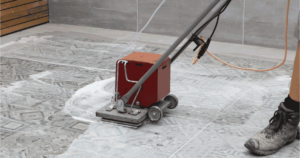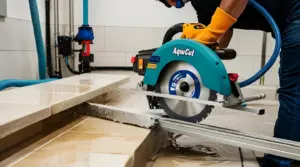We would like to share some information about diamond blades for cutting various types of material. Everything from extremely hard porcelain to natural stone.
There are many types of natural stone available, one being sandstone of varying thickness, which is very common and widely used. 20mm porcelain is a material that a lot of people seem to have problems cutting but we can provide you with the right blades that will make your job much easier.
For 20mm porcelain, if you want to do a clean cut that does not have very many chips along the actual cut, you could use a continuous rim blade. This blade will cut reasonably slow, but it will give you an exceptionally clean cut.
A segmented blade is similar to the continuous rim blade, but it is segmented with very small gaps and the violin shape allows the blade to expand and contract and allow the spoil from the cut. It still gives a very clean cut, but it is a little bit faster.
Turbo blades have a continuous rim, but the segments are platelets on the actual side of the blade and as the cutting is being done, the debris comes through the little fins out of the side to get that away from the cut, making it a faster cut. It can potentially leave you with a few chips but those can be removed with a diamond pad.
On natural stone you want to use a segmented blade that has much bigger gaps because it will be cutting much faster and it will need to remove the material from the cut a lot faster to avoid the blade clogging.
One of the things you need to know about blades and the material that they are cutting is everything has a scale of hardness and that is called the MOHS scale. A diamond is 10 and porcelain can be as much as 8.5 so you are trying to cut something that is almost as hard as the diamond with which you are working. Therefore, the blades are made with a soft metal on the matrix that supports the diamonds as you do the cutting. This soft metal can tend to wrap around the diamonds and glaze the blade over. The reason it is a soft metal is so that you can use a dressing stone after each cut to remove the slight build-up that has come from the soft metal. Tilers Tools’ dressing stones are made from a synthetic material and contain small particles of aluminium oxide. As you use the dressing stone with the machine running, it takes away the build-up of the glaze from the segments of the blade exposing the diamonds.
A hard matrix for building and stone products as they are abrasive. A soft metal matrix for hard material such as porcelain to facilitate the use of a dressing stone.
Summing up, it is extremely important to select the right blade for the material you are cutting, the right bore size and the right speed for the machine (or the grinder) that you’re using. Tilers Tools offer various blades on their website (www.tilerstools.co.uk) to cut through most materials. It can be a bit of a minefield so if ever you need any help, Tilers Tools are always at the end of the telephone on 01565 344860 to give you further advice.




